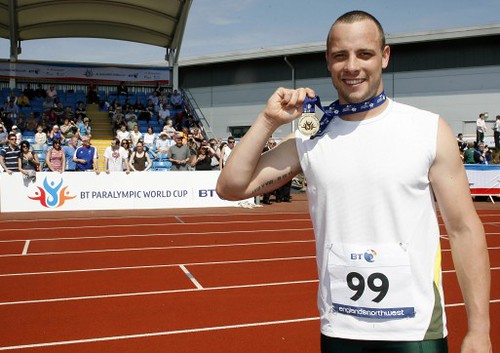Warning: Offsite links are not safe spaces. Articles and comments in the links may contain ableist, sexist, and other -ist language and ideas of varying intensity. Opinions expressed in the articles may not reflect the opinions held by the compiler of the post. I attempt to provide extra warnings for material like extreme violence/rape; however, your triggers/issues may vary, so please read with care.

More Than The Games: Pistorius hoping for fast times at the BT Paralympic World Cup
Oscar Pistorius will again be the marquee name of the 2010 BT Paralympic World Cup after the South African confirmed his participation at the annual event in May. The 23-year-old, a four-time Paralympic gold medallist, will defend his 100m and 400m titles in Manchester as he continues his bid to compete at the 2012 Olympics and Paralympics in London.
In 2008, Pistorius, dubbed the Blade Runner, was cleared to compete at in IAAF able-bodied events by Court of Arbitration for Sport, but failed to achieve the qualifying time for the 2008 Olympics by 0.7 seconds.
Laura Overstreet at LeftyByDefault.com: Things that make you go hhhmmm….
Getting a Maid of Honor dress has been a little more difficult, simply because I need separates and sizing is a little wacky with me. Not really a huge deal though. I decided that going to a dressmaker would be easiest. Or it seemed easiest until I visited one yesterday.[…]
She then said, “You are very unlucky,” and I don’t remember what I said or did, but I know I was in shock. That was a new one on me. I have been asked this question more times than I can count and never heard that one. She went on to say, “You must cry all the time.” Uh, not so much.
Wheelchair Dancer: Thinking Beyond The Label? Not Quite
The advertising campaign is the first nation-wide campaign about employment for PWD. It’s on the television and the radio; there’s a website. I have yet to see a paper version. It’s not working for me. It’s not just the slogan, “Evolve Your Workplace,” (eek — misuse! infelicities!), it’s the way disability is presented.
Activists have spent a long time trying to educate people about the dangers of assuming everyone is a “little bit disabled.”
Serene Vannoy at serenejournal: Next week: Disability Awareness Week!
Next week is Disability Awareness Week at Cal and we are working to spread the word as much as possible. […]
UC Berkeley is considered by many to be the birthplace of the disability rights movement, and the students, staff, and faculty of UCB are committed to continuing that tradition. That is why the Disabled Students Union, Disabled Students Program, and the ASUC are coordinating the fourth annual Disability Awareness Week.
UPI.com: U.N. to safeguard Haitian disabled rights
A group of U.N. experts will look into the plight of Haitians with disabilities, disproportionately affected by January’s earthquake, the United Nations said. […] The group also will look into the situation of people with disabilities in other countries affected by natural disasters, including Chile, which was struck by an 8.8-magnitude earthquake last weekend.
Sydney Morning Herald: All the world’s a stage – some can’t get in
But amid the graphs and tables illustrating the positive findings in the Australia Council for the Arts report More than Bums on Seats: Australian participation in the arts was some less palatable news: people with disabilities and migrants from non-English-speaking countries are being left behind.
The council’s last similar survey was released in 1999. How far has access to the arts progressed for people with disabilities – one in five nationwide, or more than 4 million? “Not very far would be my summary,” Australia’s Disability Discrimination Commissioner, Graeme Innes, says.
“Many, many venues are not accessible for people who use wheelchairs. There are only 15, I think, cinema screens around Australia – out of the 2000 or 3000 screens showing movies – that show movies with captions for people who are deaf or have a hearing impairment. There are even less cinemas providing audio description for people who are blind or have a vision impairment. I think that the arts community and deliverers of arts have got a long, long way to go before people with a disability are anywhere near in an equal situation.”
Sydney Morning Herald: Access still a hurdle, says film buff
Andrew Longhurst knows all about the difficulties that can discourage people with disabilities from going to shows or other forms of the arts and entertainment. As someone with a bone disorder who has used a wheelchair for most of his 35 years, he has encountered just about every barrier, beginning with physical access. “It’s a general rule that if you can’t get in the front door, it’s pretty much game over,” Longhurst says. But he’s not fussy: “Any door will do.”
Entry is just one consideration of many — from parking and distance to mobility challenges inside — when weighing up an unfamiliar venue. “I’m very adaptable . . . I can climb up steps on my backside,” he says. “I make it work. But if it’s entertainment, if it’s arts, it’s supposed to be enjoyable.”